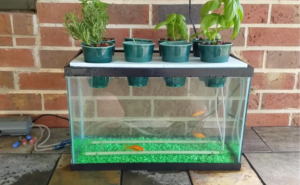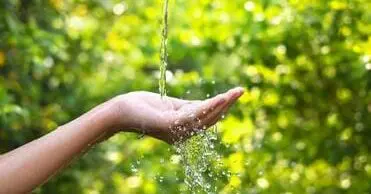Activity Content Sections
- Internet device with ability to project video, one for the educator
- Device with internet access, one per student
- Achieving Sustainable Agriculture student handout, one per student
- What is Sustainable Agriculture? student handout, one per student
- Hydroponic Solutions student handout, one per student
- Hydroponics Examples handout, one for the educator to project or share with the class
- Bottle of liquid nutrients, one per educator
- Design and Build materials, one per student:
- Empty and clean 2-liter bottle (individual water bottles work too)
- Permanent marker
- Scissors or utility knife
- 2 cotton strips, approximately 6” long
- Hydroponic growing medium (rocks, gravel, perlite, rockwool, sand)
- Large container with spout
- 1 quart of water
- Small lettuce plant (most herbs work well too)
- Soilless Farming video (https://engineeringdreamsinschool.com/educators/video-topic-series/)
Agriculture plays a huge role in the world’s economy and is responsible for most of the world’s food and fabrics. However, in many countries around the world it is also the largest source of pollution. Farming often produces excess food waste, and toxins used in traditional agriculture can harm water, air, soil, and ecosystems. Thankfully, solutions to make agriculture more sustainable and environmentally friendly do exist.
To better understand this problem and empathize with those whom it affects, students will research the global effects of traditional agricultural practices. Considering the UN’s Sustainable Development Goals, students will determine how many goals could be advanced through sustainable agriculture. They will then research solutions to this global problem as they learn about close-looped and soilless (hydroponic) farming. They will ultimately design a sustainable agriculture solution that illustrates how their family or community could implement hydroponic farming on a smaller scale.
Student Challenge
Students first learn about a non-profit organization dedicated to providing clean, safe drinking water to nearby communities. They then research global water issues before looking at any water concerns their community or region may be facing.
Success Criteria
- Define the concept of sustainable agriculture.
- Perform research to understand the environmental impact
of traditional agricultural practices. - Identify and analyze existing sustainable agriculture solutions.
- Design their own sustainable agriculture solution.
Instructions
Engage
- Begin with a class graffiti wall. Write “Agriculture” in large letters in the center of the board and call up students in small groups to write and/or illustrate what comes to mind when they see this word.
- Once all students have a chance to record their ideas, explain that agriculture is the process of growing crops and raising livestock. Agriculture is responsible for most of the world’s food and fabrics.
- Go on to explain that what is produced and how it is produced varies on the location. However, globally, one of the agricultural sector’s biggest challenges is figuring out how to feed a growing population while reducing its environmental impact. Today, students will lend a hand as they contribute to solving this problem.
- Distribute one Achieving Sustainable Agriculture handout to each student. Read through the Define the Problem section together. Kick off the activity by either reading together or having students read independently the What is Sustainable Agriculture? article distributed by the Sustainable Agriculture Research and Education (SARE) program of the USDA.
- Instruct the class to complete numbers one through three independently or with a partner. Explain that before trying to find a solution, it is important to understand the problem.
- Once about ten minutes has passed, bring the class back together. Discuss: What are some of the biggest environmental challenges of traditional agriculture?
Learn
- Explain that there are many different initiatives focused on making farming sustainable and beneficial for the environment. For instance, an organization called Re-Nuble takes advantage of food waste! In order for students to contribute to solving this problem, it is important for them to be aware of the alternatives to traditional agriculture that already exist.
- Play the Problem Solvers for Good: Making the World a Better Place Through Engineering video featuring Re-Nuble and encourage students to listen for this organization’s innovative solution. (https://engineeringdreamsinschool.com/educators/video-topic-series/)
- Then bring students’ attention to the Perform Background Research section of their handout and review the instructions. Then give the class about ten minutes to complete this section.
- Bring the class back together and discuss: How do these innovations address some of the environmental challenges of traditional agriculture?
Apply
- Now bring students’ attention to the Evaluate and Ideate section of their handout. Explain that students will apply what they have learned and continue to explore possible solutions as they further investigate the concept of hydroponic farming.
- Distribute a Hydroponic Solutions article, published by the Center for Agriculture, Food, and the Environment at the University of Massachusetts Amherst, to each student to either read as a group or independently. Provide the class a few minutes to answer the section’s first question.
- Next, challenge the class to evaluate how these existing solutions could lessen farming’s environmental impact and guide the class toward ideating their own solutions. Facilitate this by leading the class in a discussion* around the following questions. Encourage students to take notes on their handout as they participate in the conversation.
-
- Discussion Question 1: Think about the environmental impacts of traditional agriculture and how hydroponic farming may help. Which Sustainability Goal(s) could hydroponic farming positively impact?
- Discussion Question 2: Who in the world could benefit from hydroponic farming? Why?
- Discussion Question 3: In what ways could individual people or families use hydroponic principles to grow their own food? To make this possible, could you adapt a solution that already exists? Or could you engineer a brand-new solution?
*Note: If you prefer to have students complete this section individually, they may develop and record answers to the handouts independently or in pairs without participating in a class discussion.
Challenge
- Explain that now that students have defined the problem, performed background research, and ideated and evaluated, it’s time to design and build a potential solution.
- Bring students’ attention to the Design and Build section of their handout and tell the class that their challenge will be to apply what they have learned to build a small-scale hydroponic farming system that they can use to grow lettuce or herbs.
- Read through the instructions together and answer any questions as they arise. Show students where the materials are located and let them begin. Note that additional adult supervision will be required for steps 2 and 6.
Discuss
Note: This section can be completed in class as time allows, in a follow-up session, or as an at-home/extension activity.
- Encourage students to review the work they have completed. Remind them that the engineering design process is always represented as a circle and not a straight line. To develop a solution that works, engineers often must refer back to the very beginning!
- Then encourage the class to complete the final Innovate and Reiterate section of their handout. Considering what they have learned by creating a small-scale hydroponic system for a vegetable plant, how can they improve upon this design or come up with a better one that can be produced on a larger scale to serve the community?
Note: If students are having difficulty conceptualizing other hydroponic systems, share the Hydroponics Examples handout to jumpstart the design process.
Reflect
- Once students have designed a solution, facilitate students’ reflection on their learning by inviting them to summarize how hydroponic farming and their innovative designs can help achieve sustainable agriculture.
- If time allows, encourage students to share their unique design ideas with their peers. Small groups may compare and contrast their designs with each other so that students can then optimize their designs.
Learning Extensions
- Students may use their Achieving Sustainable Agriculture handout to build a prototype of their initial design in school or at home. Encourage them to record their successes and failures, as well as make improvements to their designs.
- Your class may collaborate to build and maintain a vertical garden or hydroponic garden system. The produce can then be donated to help feed your school, students’ families, local food pantries, homeless shelters, etc.
Educational Standards
Engineering Design:
- MS-ETS1-1: Define the criteria and constraints of a design problem with sufficient precision to ensure a successful solution, taking into account relevant scientific principles and potential impacts on people and the natural environment that may limit possible solutions.
Earth and Human Activity:
- MS-ESS3-1: Construct a scientific explanation based on evidence for how the uneven distributions of Earth’s mineral, energy, and groundwater resources are the result of past and current geoscience processes.
- MS-ESS3-3: Apply scientific principles to design a method for monitoring and minimizing a human impact on the environment.
Standards for Technological Literacy (ITEAA Standards)
Standard 1: Students will develop an understanding of the characteristics and scope of technology. In order to comprehend the scope of technology, students should learn that:
- F. New products and systems can be developed to solve problems or to help do things that could not be done without the help of technology.
- G. The development of technology is a human activity and is the result of individual or collective needs and the ability to be creative.
Standard 4: Students will develop an understanding of the cultural, social, economic, and political effects of technology. In order to recognize the changes in society caused by the use of technology, students should learn that:
- D. The use of technology affects humans in various ways, including their safety, comfort, choices, and attitudes about technology’s development and use.
Standard 8: Students will develop an understanding of the attributes of design. In order to comprehend the attributes of design, students should learn that:
- E. Design is a creative planning process that leads to useful products and systems. • G. Requirements for a design are made up of criteria and constraints.
Common Core English Language Arts Standards
Reading:
- R.7: Integrate and evaluate content presented in diverse media and formats, including visually and quantitatively, as well as in words.
Writing:
- W.4: Produce clear and coherent writing in which the development, organization, and style are appropriate to task, purpose, and audience.
- W.7: Conduct short as well as more sustained research projects based on focused questions, demonstrating understanding of the subject under investigation.
Speaking & Listening:
- SL.1: Prepare for and participate effectively in a range of conversations and collaborations with diverse partners, building on others’ ideas and expressing their own clearly and persuasively.








7 Comments